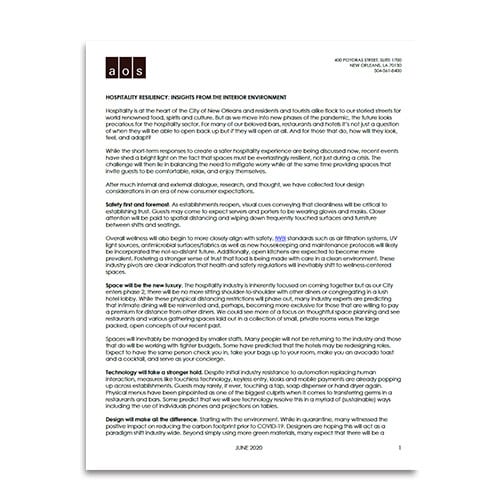
17 Jun Hospitality Resiliency: Insights from the Interior Environment
Hospitality is at the heart of the City of New Orleans. Residents and tourists alike flock to our storied streets for world renowned food, spirits and culture. But as we move into new phases of the pandemic, the future looks precarious for the hospitality sector. For many of our beloved bars, restaurants and hotels it’s not just a question of when they will be able to open back up but if they will open at all. And for those that do, how will they look, feel, and adapt?
While the short-term responses to create a safer hospitality experience are being discussed now, recent events have shed a bright light on the fact that spaces must be everlastingly resilient, not just during a crisis. The challenge will then lie in balancing the need to mitigate worry while at the same time providing spaces that invite guests to be comfortable, relax, and enjoy themselves.
After much internal and external dialogue, research, and thought, we have collected four design considerations in an era of new consumer expectations.
Safety first and foremost. As establishments reopen, visual cues conveying that cleanliness will be critical to establishing trust. Guests may come to expect servers and porters to be wearing gloves and masks. Closer attention will be paid to spatial distancing and wiping down frequently touched surfaces and furniture between shifts and seatings.
Overall wellness will also begin to more closely align with safety. IWBI standards such as air filtration systems, UV light sources, antimicrobial surfaces/fabrics as well as new housekeeping and maintenance protocols will likely be incorporated the not-so-distant future. Additionally, open kitchens are expected to become more prevalent. Fostering a stronger sense of trust that food is being made with care in a clean environment. These industry pivots are clear indicators that health and safety regulations will inevitably shift to wellness-centered spaces.
Space will be the new luxury. The hospitality industry is inherently focused on coming together but as our City enters phase 2, there will be no more sitting shoulder-to-shoulder with other diners or congregating in a lush hotel lobby. While these physical distancing restrictions will phase out, many industry experts are predicting that intimate dining will be reinvented and, perhaps, becoming more exclusive for those that are willing to pay a premium for distance from other diners. We could see more of a focus on thoughtful space planning and see restaurants and various gathering spaces laid out in a collection of small, private rooms versus the large packed, open concepts of our recent past.
Spaces will inevitably be managed by smaller staffs. Many people will not be returning to the industry and those that do will be working with tighter budgets. Some have predicted that the hotels may be redesigning roles. Expect to have the same person check you in, take your bags up to your room, make you an avocado toast and a cocktail, and serve as your concierge.
Technology will take a stronger hold. Despite initial industry resistance to automation replacing human interaction, measures like touchless technology, keyless entry, kiosks and mobile payments are already popping up across establishments. Guests may rarely, if ever, touching a tap, soap dispenser or hand dryer again. Physical menus have been pinpointed as one of the biggest culprits when it comes to transferring germs in a restaurants and bars. Some predict that we will see technology resolve this in a myriad of (sustainable) ways including the use of individuals phones and projections on tables.
Design will make all the difference. Starting with the environment. While in quarantine, many witnessed the positive impact on reducing the carbon footprint prior to COVID-19. Designers are hoping this will act as a paradigm shift industry wide. Beyond simply using more green materials, many expect that there will be a
greater return to nature, sunlight, and fresh air. Hotels may invest more in wellness spaces; restaurants might focus on open-air dining. Environmental considerations will need to extend beyond the physical space. Packaging demands have increased drastically in the short-term and it will be imperative for designers to find safe ways to minimize plastic consumption.
Some have predicted a new form of architectural modernism may arise. Historians have interpreted mid-century modernism as a response to early 20th century health crises such as cholera, typhoid and the flu. Design following COVID-19 may tend towards strict geometries, more anti-microbial materials, and minimizing ornamentation that can trap dangerous microbes.
Adaptability will also be key and more relevant than ever before. Restaurants may be considering ways to diversify their offerings. Can the bar become part wine shop? Can excess kitchen space be converted into a delivery station? Hotels will be looking at ways to create spaces that are flexible and support a responsive business model as well. For example, creating meeting spaces that can both host a wedding or convention but can quickly pivot to a medical triage space. This and many other considerations will require agile design and room for comfort.
While the future is uncertain, one thing remains – people in New Orleans will continue to gather, eat and drink, travel, and celebrate. The design industry has a responsibility and opportunity to innovate and reinvent hospitality experiences to help our clients rethink service in the near-term while looking ahead at resilient business strategies for a “future normal.” Design professional or not, we can all play a role in a successful return by patronizing our favorite local businesses as they navigate a new world.
Click here to download a printable version of the white paper.

Want to learn more?
Check out these additional resources and thought-starters discussing what’s next for the hospitality industry:
New Orleans & Company Coronavirus Toolkit for the Hospitality Community
Campo Architects The Future of Hotel Design Post-COVID-19
GNO, Inc. Getting Back to Work in the New Normal
Hospitality Design June 2020 – The Hotel Issue
Contract June 2020 – Design During Crisis

No Comments